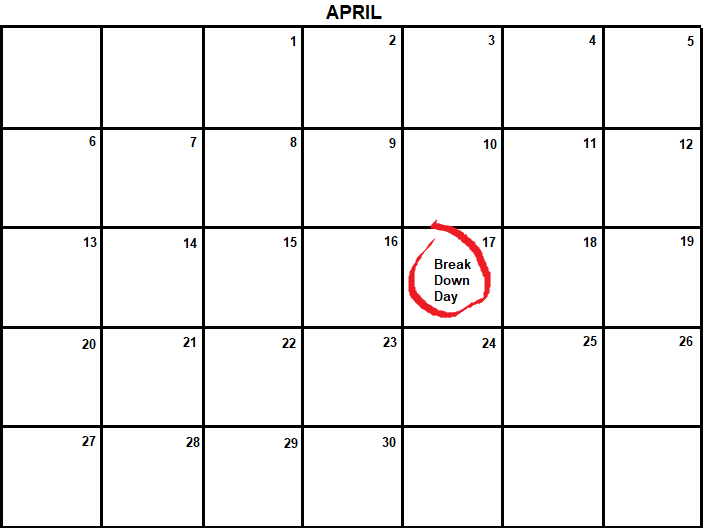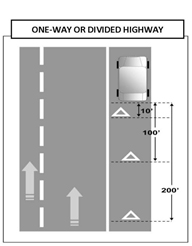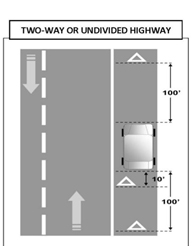Fuel for Thought

Plan Your Breakdown
Truck drivers can plan for a multitude of events. Many things can be pre-planned, and most probably are. The nature of expediting is such that planning loads in advance can be rare. Expedited freight, or emergency freight, doesn’t always come with early notification. While you may not be able to pre-plan loads too far in advance, many things you can, like where to fuel, where to go after your delivery, time off, etc.
One thing that never gets planned is a roadside breakdown. You cannot plan when a breakdown will occur, but you can plan to be prepared for it when it happens. We can keep our trucks serviced and in top condition, but mechanical and electronic issues can appear out of nowhere. We can monitor tire wear but cannot plan for the debris on the roadway that may puncture a tire leaving us on the shoulder of a road. Filters can clog. Belts can break. Animals can enter the roadway (and our radiators). Parts can and do fail. Then we find ourselves on the shoulder of the road. Now what? You were not planning to be here.
First thing to do is stay calm (your 4 way emergency flashers should already be on). When a driver has just had an event that caused them to be on the shoulder of a road disabled, many things can go through your mind. What happened? How did it happen? Can I perform a roadside repair? Do I need to call dispatch or a customer if I am going to be late because of this? With these and many other questions to answer, assessing the cause of your breakdown is crucial.
If your truck is disabled, not driveable, the first thing to do is get out your emergency triangles and PROPERLY place them for other motorists to be warned.
If you do not already know, now is a great time to learn the PROPER way to use your emergency triangles. It is better to know now than to scramble on the roadside while dealing with equipment failure.
When you drive into a construction zone, do they ever just block a lane? No, there are warning signs and then when the cones or barrels do start to close a lane, it is usually a gradual angle to direct you. Apply that principle with setting your triangles. Do not just place them anywhere. There are reasons why you have to carry three (3) of them. It is even in the regulations about placement.
§392.22 Emergency signals; stopped commercial motor vehicles.
(a) Hazard warning signal flashers. Whenever a commercial motor vehicle is stopped upon the traveled portion of a highway or the shoulder of a highway for any cause other than necessary traffic stops, the driver of the stopped commercial motor vehicle shall immediately activate the vehicular hazard warning signal flashers and continue the flashing until the driver places the warning devices required by paragraph (b) of this section. The flashing signals shall be used during the time the warning devices are picked up for storage before movement of the commercial motor vehicle. The flashing lights may be used at other times while a commercial motor vehicle is stopped in addition to, but not in lieu of, the warning devices required by paragraph (b) of this section.
(b) Placement of warning devices—(1) General rule. Except as provided in paragraph (b)(2) of this section, whenever a commercial motor vehicle is stopped upon the traveled portion or the shoulder of a highway for any cause other than necessary traffic stops, the driver shall, as soon as possible, but in any event within 10 minutes, place the warning devices required by §393.95 of this subchapter, in the following manner:
(i) One on the traffic side of and 4 paces (approximately 3 meters or 10 feet) from the stopped commercial motor vehicle in the direction of approaching traffic;
(ii) One at 40 paces (approximately 30 meters or 100 feet) from the stopped commercial motor vehicle in the center of the traffic lane or shoulder occupied by the commercial motor vehicle and in the direction of approaching traffic; and
(iii) One at 40 paces (approximately 30 meters or 100 feet) from the stopped commercial motor vehicle in the center of the traffic lane or shoulder occupied by the commercial motor vehicle and in the direction away from approaching traffic.
(2) Special rules—(i) Fusees and liquid-burning flares. The driver of a commercial motor vehicle equipped with only fusees or liquid-burning flares shall place a lighted fusee or liquid-burning flare at each of the locations specified in paragraph (b)(1) of this section. There shall be at least one lighted fusee or liquid-burning flare at each of the prescribed locations, as long as the commercial motor vehicle is stopped. Before the stopped commercial motor vehicle is moved, the driver shall extinguish and remove each fusee or liquid-burning flare.
(ii) Daylight hours. Except as provided in paragraph (b)(2)(iii) of this section, during the period lighted lamps are not required, three bidirectional reflective triangles, or three lighted fusees or liquid-burning flares shall be placed as specified in paragraph (b)(1) of this section within a time of 10 minutes. In the event the driver elects to use only fusees or liquid-burning flares in lieu of bidirectional reflective triangles or red flags, the driver must ensure that at least one fusee or liquid-burning flare remains lighted at each of the prescribed locations as long as the commercial motor vehicle is stopped or parked.
(iii) Business or residential districts. The placement of warning devices is not required within the business or residential district of a municipality, except during the time lighted lamps are required and when street or highway lighting is insufficient to make a commercial motor vehicle clearly discernable at a distance of 500 feet to persons on the highway.
(iv) Hills, curves, and obstructions. If a commercial motor vehicle is stopped within 500 feet of a curve, crest of a hill, or other obstruction to view, the driver shall place the warning signal required by paragraph (b)(1) of this section in the direction of the obstruction to view a distance of 100 feet to 500 feet from the stopped commercial motor vehicle so as to afford ample warning to other users of the highway.
(v) Divided or one-way roads. If a commercial motor vehicle is stopped upon the traveled portion or the shoulder of a divided or one-way highway, the driver shall place the warning devices required by paragraph (b)(1) of this section, one warning device at a distance of 200 feet and one warning device at a distance of 100 feet in a direction toward approaching traffic in the center of the lane or shoulder occupied by the commercial motor vehicle. He/she shall place one warning device at the traffic side of the commercial motor vehicle within 10 feet of the rear of the commercial motor vehicle.
(vi) Leaking, flammable material. If gasoline or any other flammable liquid, or combustible liquid or gas seeps or leaks from a fuel container or a commercial motor vehicle stopped upon a highway, no emergency warning signal producing a flame shall be lighted or placed except at such a distance from any such liquid or gas as will assure the prevention of a fire or explosion.


Proper placement can warn approaching drivers of your presence and help avoid a collision while you make the necessary repairs or wait for the wrecker to arrive. Having pre-planned for a breakdown also includes having phone numbers to call for help before you need it.
Be safe and be prepared.
See you down the road,
Greg
